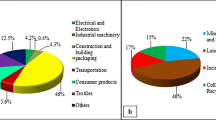Abstract
A series of waterborne polyurethane (WPU) with different hard segment content were synthesized by a prepolymer mixing process from isophorone diisocyanate, dimethylol propionic acid, the glycolyzed product of poly(ethylene terephthalate) as the soft segment and trimethylol propane as the crosslinking agent. The effect of the hard segment content on the thermal and mechanical properties of WPU films was studied. The results reveal that the hard segment content play a key role in the thermal and physical-mechanical properties of the WPU films. The waterborne polyurethane synthesized from circulating reuse of waste PET materials have good thermal stability and mechanical properties, which is confirmed their potential application as protective and decorative coatings.
Similar content being viewed by others
References
S. M. Cakić, I. S. Ristić, and M. M-Cincović, Prog. Org. Coat. 76, 1484 (2013).
D. S. Achilias and G. P. Karayannidis, in Proceedings of the International Conference “Protection and Restoration of the Environment VI,” Skiathos, Greece, 2002.
M. Ghaemy and K. Mossaddegh, Pol. Degrad. Stab. 90, 570 (2005).
U. R. Vaidya and V. M. Nadkarni, J. Appl. Pol. Sci. 35, 775 (1988).
X. L. Luo and Y. B. Li, J. Pol. Environ. 22 (3), 318 (2014).
G. Güçlü, Pol. Bull. 64, 739 (2010).
J. Y. Kim, D. Y. Jeong, C. H. Son, et al., Korean J. Chem. Eng. 24, 1076 (2007).
S. Katoch, V. Sharma, and P. P. Kundu, Bull. Mater. Sci. 36, 277 (2013).
S. R. Shukla, A. M. Harad, and L. S. Jawale, Pol. Degrad. Stab. 94, 604 (2009).
A.M. Atta, A. F. El-Kafrawy, M. H. Aly, and A. A. Abdel-Azim, Prog. Org. Coat. 58, 13 (2007).
S. Y. Lee, J. S. Lee, and B. K. Kim, Pol. Int. 42, 67 (1997).
J. J. Li, W. Zheng, W. B. Zeng, et al., Appl. Surf. Sci. 307, 205 (2014).
X. Liu, Y. Guo, K. Xu, et al., J. Macromol. Sci., Ser A 49, 1070 (2012).
Y. S. Lu and R. C. Larock, Biomacromolecules 9, 3332 (2008).
R. López-Fonseca, I. Duque-Ingunza, B. D. Rivas, et al., Chem. Eng. J. 168, 312 (2011).
U. Biermann, W. Friedt, S. Lang, et al., Angew. Chem. Int. Ed. 39, 2206 (2000).
C. B. Wang and S. L. Cooper, Macromolecules 16, 775 (1983).
V. García-Pacios, V. Costa, M. Colera, and J. M. Martín-Martínez, Int. J. Adhes. Adhes. 30, 456 (2010).
Y. H. Guo, J. J. Guo, H. Miao, et al., Prog. Org. Coat. 77, 988 (2014).
V. García-Pacios, M. Colera, Y. Iwata, and J. M. Martín-Martínez, Prog. Org. Coat. 76, 1726 (2013).
Author information
Authors and Affiliations
Corresponding author
Additional information
The article is published in the original.
Rights and permissions
About this article
Cite this article
Wang, C., Fang, J., Liu, T. et al. Synthesis of waterborne polyurethane dispersions with glycolyzed product from pet waste: Effect of hard segment content on its properties. Polym. Sci. Ser. B 57, 434–443 (2015). https://doi.org/10.1134/S1560090415050188
Received:
Accepted:
Published:
Issue Date:
DOI: https://doi.org/10.1134/S1560090415050188




